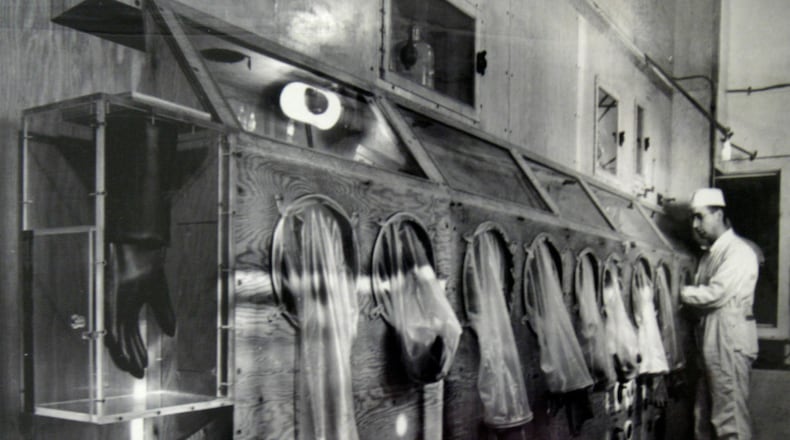Work on the Manhattan Project, the secret government effort to build an atomic bomb and the subject of the movie “Oppenheimer,” which on Tuesday received 13 Oscar nominations, was done in many cities, including Dayton.
The most important work done in what was called the Dayton Project, was the manufacturing of the triggers that start the atomic chain reaction in the bombs.
The man in charge
Charles Allen Thomas, a research director at Dayton’s Monsanto Chemical Company, was among a handful of internationally known scientists who were summoned to Washington in early 1943 and secretly briefed by Brig. Gen. Leslie Groves on the nation’s program to develop an atomic bomb.
Thomas was offered a co-directorship of the project, along with J. Robert Oppenheimer, but declined for family and career reasons since the position would have required moving to Los Alamos, New Mexico, where the Manhattan Project was headquartered.
Thomas did agree to oversee the development of the polonium trigger in Dayton, as well as the chemical research taking place at other Manhattan Project sites.
In the end, Thomas was one of just 14 scientists among the thousands involved in the Manhattan Project to be awarded the Medal for Merit, the highest civilian honor for wartime service.
Thomas’ career at the Monsanto Chemical Company continued to rise after the war. He served as president of Monsanto from 1951 to 1960 and as chairman of the board from 1960 to 1965 before retiring from the company in 1970. He died in 1982.
The polonium trigger
Early in their work, Los Alamos researchers realized that rapidly mixing polonium with beryllium would release a burst of neutrons that could initiate a chain reaction before the critical mass blew itself apart. But there had never been enough polonium produced to even see it. Dayton scientists worked out the methods for separating sufficient polonium from irradiated bismuth slugs, purifying it, and forming it into the bomb triggers.
According to a 1983 Dayton Daily news article, written shortly after documents about the Dayton Project were declassified, polonium “was a soft, silvery-looking metal. If you turned off the lights, you see a faint, purple glow, which would intensify as the purity increased.”
The Dayton trigger was a key technical hurdle in not only the bombs of World War II, but also in hundreds of atomic bombs produced after the war.
By the Dayton Project’s end in 1949, there were 334 full-time employees.
These pioneering employees at Dayton’s Monsanto facilities risked their lives to develop the bombs’ triggers with the highly radioactive polonium. But no deaths or injuries were ever reported as the result of exposure to polonium during the Dayton Project.
Local sites
Two Dayton sites associated with the Manhattan Project still exist — the storage buildings surrounding the former Bonebrake Theological Seminary, 1601 W. First St., and the building at 601 E. Third St. that was the General Electric Supply Warehouse.
The former Bonebrake Theological Seminary property, which was being used as a warehouse for the Dayton School District, was leased to Monsanto and eventually included some 20 smaller buildings covering nearly a city block.
Bonebrake Seminary was condemned and torn down in the early 1950s by its owner, the Dayton Board of Education, which had no idea of its historical significance at the time.
The General Electric Supply Warehouse is now fittingly known as the Manhattan Building.
From 1946 to 1948 after the initial development of the bomb, the Monsanto Company leased the building’s three upper floors, coined it the “Warehouse” and created a laboratory to test the biological impact of polonium radiation on humans.
General Electric remained on the three lower floors.
It was home to one of the nation’s first radiation health safety programs. Thousands of urine samples from Dayton Project personnel were screened for polonium exposure. In addition, the biological uptake and effects of polonium were studied on mice and rats.
Two others have been torn down — the original Monsanto research lab at 1515 Nicholas Road and the former Runnymede Playhouse in Oakwood.
Preliminary research was conducted at the Monsanto facility on Nicholas Road. X-ray and spectrographic work on polonium remained there until 1949, when Mound Laboratory in Miamisburg was completed.
When more space was needed for the Dayton Project, Thomas, who was married to Margaret Talbott, suggested the Army take over the Runnymede Playhouse, a massive glass-topped structure that was part of his wife’s family’s estate.
The Playhouse had been the leisure palace of the Talbott family, with giant ballroom, indoor squash and tennis courts as well as a stage for community theater.
Thomas promised to return the building to the family intact after the war — a promise he wouldn’t be able to keep. Too radioactively “hot” to clean and restore, the Playhouse was dismantled in 1950 and was later buried in Tennessee.
Credit: Tom Gilliam
Credit: Tom Gilliam
Credit: Tom Gilliam
Credit: Tom Gilliam
About the Author







